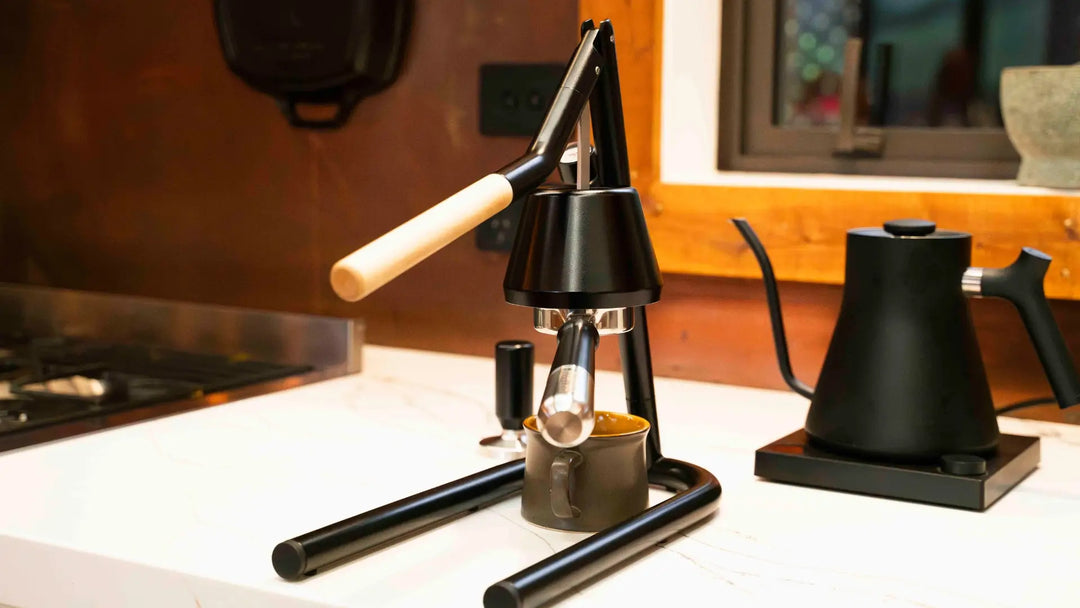Pre-infusion for Manual Espresso - Everything you need to know.
Why Learn About Pre-Infusion for Manual Espresso?
Extracting espresso with a manual espresso machine and the brewing process, as we have mentioned many times, is a game of controlling variables like pressure profiles, extraction times, water pressure, water temperature, coffee grind size and ground coffee weight to achieve consistency.
Pre-infusion is one of the tools in your arsenal, to achieve great coffee. Yet, do you know how it affects extraction, the flavours in your final cup, or when and how to use it?
Our aim here at Newton Espresso is to not only teach coffee enthusiasts how to make great manual coffee at home, but it’s also a little about the "how" and "why".
With this extra knowledge, you can pick and choose different techniques to suit your coffee, your manual espresso machine and the situation at hand. As the old saying goes, teach a man to fish, right?
One of the great advantages of using lever machines is uninterrupted control over your flow profile including whether to use pre-infusion and how long you pre-infuse for.

What is pre-infusion and why use it?
Pre-infusion is a term used in coffee, for infusing or saturating the coffee puck with hot water before beginning the full extraction.
This technique aims to evenly saturate the whole coffee bed. Firstly, this allows a release of C02 before the full extraction begins. C02 gases repel water from the grounds inhibiting some extraction of the coffee particles. Secondly, it enables the hot water to move more evenly throughout all the grinds when the full flow of water begins and the bars of pressure increase, reducing channeling and aiding extraction.
A fully saturated coffee puck, with built up gases released, can flow much faster than the same coffee without pre - infusion. This means we can grind finer while still maintaining a great flow rate with the brew lever and keeps channeling to a minimum while also boosting our extraction.
Pre-infusion can also help lengthen water contact times on less soluble coffees - like lighter roasts.
It can also help disperse gases in very fresh ground coffee. If you are stuck using coffee grounds that haven't been rested very long, a longer pre-infusion can assist in reducing the gases and harshness of the coffee.

How to use pre-infusion properly.
Pre-infusion when brewing with a manual espresso machine, is a simple technique to employ. Like with many of the techniques we have discussed, using it properly and consistently involves measuring and controlling your variables.
With manual lever espresso machines like the Brua, this involves you physically changing the rate that you press the brew lever, giving you full control over your brew pressure and pre-infusion.
It's often thought that having a super slow flow rate is best for pre-infusion, however this is not really the case. Because extraction will begin, the moment hot water touches the coffee particles, it is best to employ a steady even flow of water to the coffee. Basically we don't want the top half of the coffee bed to have drastically more water contact time than the bottom half. This would mean the top half would experience an over extraction, adding astringency to the final cup.
This doesn't mean you should slam the lever down super hard!
Instead try pressure profiling by applying even brew pressure at your standard flow rate. Once you see the coffee start to appear on the bottom of the basket, monitor the pressure gauge and hold the brewing pressure there, don't keep pushing the lever down further. Hold this pressure for anywhere between 4-12 seconds. Continue pressing the shot from here to your desired yield.
You may notice the resistance in the coffee puck is less than before the pre-infusion, this is perfectly fine and indicates an even water distribution that occurs with correct pre-infusion. If it is flowing with no resistance at all or too little resistance, simply fine up the coffee grounds to accommodate for the added pre-infusion.

When should you use pre-infusion?
While I use pre-infusion when making nearly every coffee, it is part of the extraction process and therefore does affect flavour. Most of the time, with a manual espresso machine, this is in a positive way.
Sometimes, no pre - infusion can produce a tastier cup (or at least very little pre-infusion), especially with very easy to extract coffees that bring more acidity to coffees that could be dull without it.
With many parts of coffee, the best way to understand when to use pre-infusion is through experience and experimentation. Try with and without. Try short times of 4 seconds, or longer times of 12 seconds. Taste with intent. Take notice of the differences in flavours and what you like.
When shouldn't you use pre-infusion?
Pre-infusion, while beneficial in most brewing contexts, may not be suitable for all situations. For instance, when working with very fresh coffee beans as mentioned above, the carbon dioxide released during the roasting process can create excessive pressure in the brew chamber during the pre-infusion phase, potentially leading to uneven extraction and undesirable flavours. Hence why we recommend a longer pre-infusion time.
Additionally, if the brewing method requires a quick extraction, such as in espresso preparation, pre-infusion can prolong the brewing time. Moreover, in cases where a more intense flavour profile is desired, skipping pre-infusion may allow for the development of bolder and richer tastes. Therefore, it is essential to assess the specific coffee characteristics and the desired outcome before deciding to eliminate or incorporate pre-infusion into the brewing process.
Final thoughts…
One of the greatest advantages of the Brua is the ability to fully control your extraction water flow rate. Finding the same ability on a pump driven machine is possible, however, not without a huge cost. Even then, there are very few that can offer this level of brewing process control.
We highly recommend using this pre-infusion technique to unlock the full potential of your specialty coffee at home. In fact, play with different levels of pre-infusion; push past the 12 seconds and try 20-or 30 seconds - especially with a lighter roast type of coffee or a medium roasted coffee. This falls into the category of what we call bloomed espresso - a topic we will cover in our more advanced posts in the future.
Until next time, enjoy what you have learned, enjoy your coffees and the journey of espresso!




